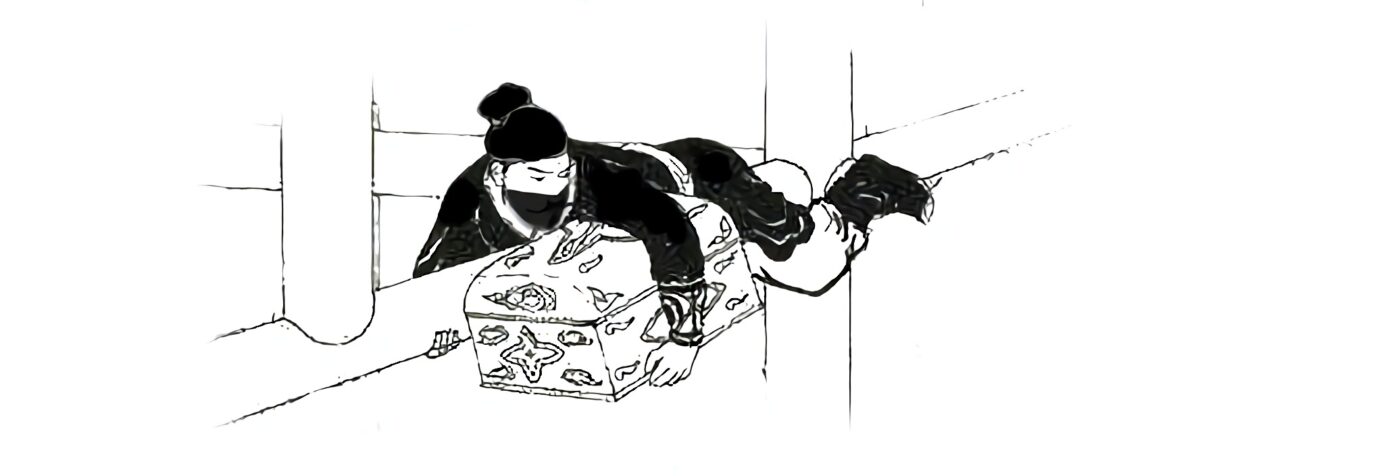
Idiom and Euphemism: liáng shàng jūnzǐ 梁上君子, a ‘gentleman on the roof beam’ encapsulates a cultural understanding of theft that balances irony and moral instruction, making it both an idiom and a euphemism.
Meaning: A euphemism for a thief. An idiom that uses the term to admonish the thief and illustrate that individuals who commit wrongful acts are not necessarily bad by nature; rather, they may have fallen into bad habits due to circumstances.
Origin: The phrase originates from the Hòu Hàn Shū 後漢書, written by Huá Jiāo 華嶠 during the Jin 晋 dynasty (266–420 CE).
Historical Explanation: Chén Shí 陳寔, was a native of Xǔ 許 during the Eastern Han, 東漢 ( 25-220 CE) period. He was known for his calm personality and fair dealings; even after his retirement, local villagers would seek his judgment during disputes, making him a role model in the community. One night, a thief broke into his home and hid in the beams, intending to steal valuables. However, Chén Shí 陳寔 discovered him. Instead of raising an alarm, he gathered his descendants and sternly admonished them, saying, “One must always strive to improve oneself and must not become complacent. Those who do wrong are not inherently bad; they simply do not hold themselves to strict standards and do not know how to learn righteousness. Over time, this leads to the formation of bad habits! Just like that ‘gentleman on the roof beam‘ 梁上君子.” Upon hearing this, the thief was greatly startled and jumped down from the beams. Chén Shí 陳寔 told him, “You don’t look like a bad person; perhaps you resorted to this desperate measure out of poverty. Here, I will give you two pieces of silk.” From that time on, thefts ceased to occur in the county. Later, “梁上君子” (liáng shàng jūnzǐ) (gentleman on the roof beam) became a euphemism for thieves but the philosophy of the idiom is more complex.
Semantic Explanation: A euphemism for a thief.
Usage Category: Used to refer to “thieves or petty criminals.”
Example Sentences:
- Alas! I just purchased some jewelry, and now I’ve been visited by a ‘gentleman on the roof beam.’
- Hey, brother! If you want to come, please use the front door; don’t be like the ‘gentleman on the roof beam’ and climb through the window!
- Last night, a ‘gentleman on the roof beam’ visited our building and rummaged through every household.
- Once a home is invaded by a ‘gentleman on the roof beam,’ the family often lives in constant fear.
As an Idiom:
Chén Shí 陳寔 who, upon discovering a thief hiding in his home, used the phrase to describe him in a way that softened the connotation of theft.
-
Figurative Meaning: The term refers to a thief, but it implies a level of sophistication or cunning that distinguishes the act of stealing from more violent or direct forms of crime. The use of “gentleman” adds a layer of irony, suggesting that the thief possesses a semblance of respectability despite engaging in dishonest acts. At this time in history there were indeed many people reduced to ways of life they would normally not engage in. Thievery was often a means of survival and the regret of many such unfortunate people have been recorded in Chinese history.
-
Cultural Context: The idiom highlights a moral lesson about self-improvement and accountability. In the original story, Chén Shí 陳寔 uses the term to admonish the thief and illustrate that individuals who commit wrongful acts are not necessarily bad by nature; rather, they may have fallen into bad habits due to circumstances.
-
Common Usage: In contemporary usage, gentleman on the roof beam 梁上君子 is employed in conversations about theft, often to refer to petty criminals or thieves in a light-hearted or humorous manner.
Author’s Note: In our studies, we have encountered other anecdotes featuring stealthy thieves and their climbing abilities. Such stories not only illustrate the physical skills required of stealth operatives but also underscore the psychological aspects of their craft. The ability to navigate and utilize vertical spaces like roof beams reflects the strategic thinking and adaptability essential to successful stealth operations, paralleling the principles we examine in our research on ancient and modern practices of stealth.
